Chapter: Introduction to Human Nutrition: Food Composition
Foods - Food Composition
Foods
Food composition tables normally consist of a list of selected foods with data on the content of selected nutrients in each food. For a food composition table to be of value in estimating nutrient content, a significant portion of the foods consumed by the group or indi-vidual being studied, as well as the nutrients of interest, should be present in the table. To a large extent this relationship is critical in determining the quality of the information obtained by using the tables, assuming that the data in the tables are of a desirable quality.
Criteria for inclusion in tables
The identification of potential contributions of foods to the diet of the population group being studied is unquestionably the first step in identifying and select-ing which foods should and should not be included in the production of a database. However, common sense dictates that it is unreasonable to expect that all foods consumed by all individuals at all times be included in a specific food composition table at any one time. Therefore, most tables aim to include all foods that form a major part of the food supply and that are major contributors to the diet in the forms most commonly obtained or consumed, and as many as possible of the less frequently consumed foods. For instance, in the USA the number of foods contribut-ing to quartiles of critical nutrient intakes was identi-fied as the following: 9 foods contribute to 25% of food intake, 34 foods to 50%, 104 to 75%, and 454 to approximately 100%.
Databases can be compiled directly, where the compiler initiates sampling and analyses to obtain the data, or indirectly by drawing on the following sources of data, in order of preference:
●original analytical values
●imputed values derived from analytical values from a similar food, e.g., values for “boiled” used for “steamed”
●calculated values derived from recipes, calculated from the ingredients and corrected for preparation factors
●borrowed values (refers to using data originally generated or gathered by someone else) from other tables and databases.
Today, database compilers normally draw on a com-bination of the direct and indirect methods.
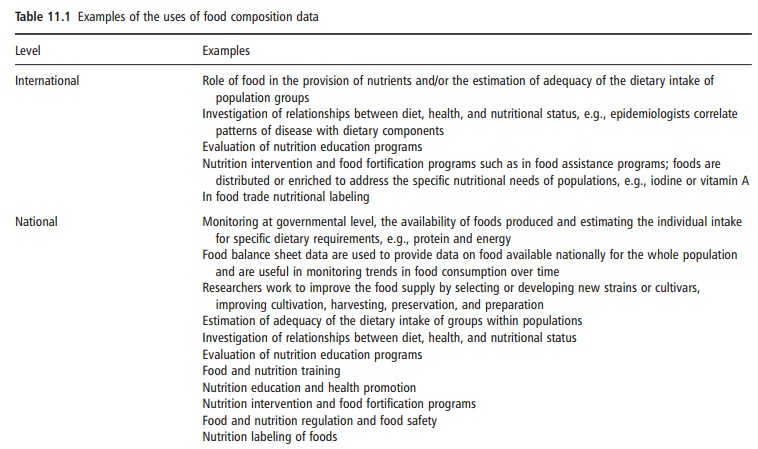
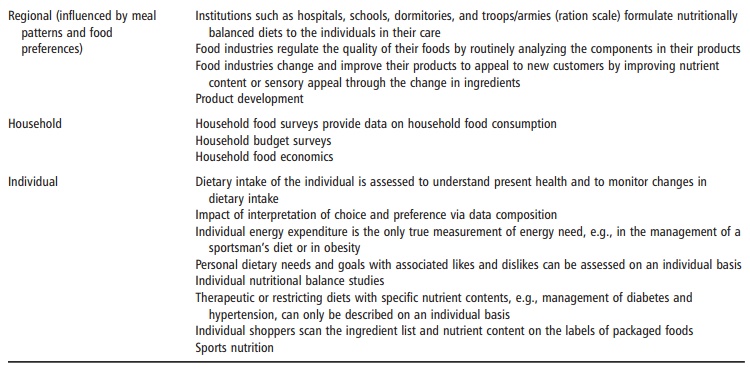
Description of foods
The food described in the food composition table should be recognizably similar to that being con-sumed by the individual or group. The precise descrip-tion of foods is a difficult task and much is required to ensure that foods are described adequately. The introductory material (description and explanation) in a printed table may be almost as important as the data values. By using several words to describe a food, called an extended or multifaceted description, the chance of misinterpreting the data is reduced. As internationalization of food composition data con-tinues, linguistic aspects of defining foods, with one definition meaning different things in different cul-tures and even from place to place within countries, are highlighted. For instance, sorbet or sherbet is made by beating whisked egg whites into the partly frozen mixture such as in apple sorbet and lemon sorbet. However, the term sorbet is preferred to sherbet, since the latter can also refer to a flavored, sweet, sparkling powder or drink, or a drink of sweet diluted fruit juice. The name tortilla is also applied to a variety of foods in Latin America. In Africa morogo is a collective term used for a variety of indigenous green leafy vegetables harvested from the veld. Using scientific names for food items is not necessarily a solution, since the relationship between common name and scientific name is neither consistent nor universally unique, for example the German tables group pears and apples in the same genus, while the British and US tables separate them.
Many structured food description systems have been proposed. These systems should be adapted to the specific purpose (e.g., nutrient content, pesticide regulation) for which they are intended. For example, the FAO Committee report, INFOODS Guidelines for Describing Foods: A Systematic Approach to Des-cribing Foods to Facilitate International Exchange of Food Composition Data, published in 1991, was designed to facilitate interchange of food composi-tion data between nations and cultures. The system is a broad, multifaceted, and open-ended description mechanism using a string of descriptors for foods. The International Food Data System Project (INFOODS) Nomenclature and Terminology Com-mittee has developed guidelines for describing foods to facilitate international exchange of food composi-tion data. INFOODS is a comprehensive effort, begun within the United Nations University Food and Nutri-tion Program to improve data on the nutrient com-position of food from all parts of the world. In line with the FAO’s lead role in classification of agricul-tural activities and products, and to facilitate interna-tional data comparability and exchange, FAOSTAT has developed and standardized the Harmonized Commodity Description and Coding System in 1996. The coding system has developed multipurpose goods’ nomenclature used as the basis for trade sta-tistical nomenclatures all over the world.
In 1975 the Food and Drug Administration (FDA) of the USA developed a controlled vocabulary for food description, based on the principle of a faceted thesaurus, where each food indexed is described by a set of standard terms grouped in facets, characteristic of the product type of a food source and process applied to food ingredients. Examples are the biologi-cal origin, the methods of cooking and conservation, and technological treatments. It is an automated method for describing, capturing, and retrieving data about food, adapted to computerized national and international food composition and consumption databanks, and is therefore language independent. In Table 11.2 an example of the application of LanguaL is presented. More information can be obtained from the LanguaL (Langua aLimentaria or “language of food”) homepage (www.langual.org). LanguaL is an international framework for food description, which the European LanguaL Technical Committee has administered since 1996. The thesaurus is organized into 14 facets of the nutritional and/or hygienic quality of foods. These include the biological origin, the methods of preparation or conservation. The European LanguaL Technical Committee has linked LanguaL to other international food categorizing and coding systems including the CIAA Food Catgorizing System, Codex Classifications, and E-numbers used for additive identifications.
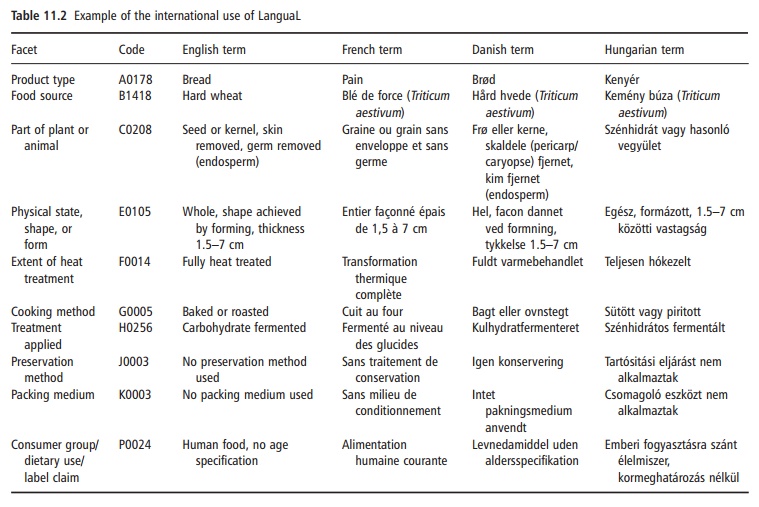
Classification of foods
Most food composition tables are organized accord-ing to the classification of foods into food groups, with food items listed alphabetically within each food group. For example, the fruit group could start with apples and end with tangerines. A simple coding system could supplement the alphabetically listed foods (used in the British tables), but it presents a problem when a new food is introduced and all the codes have to change. Although food groups of different countries and organizations are never completely identical, they are usually recognizably similar. However, problems normally arise with the description of cooked mixed dishes where a dish can be equally well described by one or more food group. In some tables, particularly those for educational purposes, there are subgroups based on the content of specific nutrients such as high-fat and low-fat dairy products. Table 11.3 provides an example of major food groups that are used by the FAO for their food balance sheets and regional food composition tables.
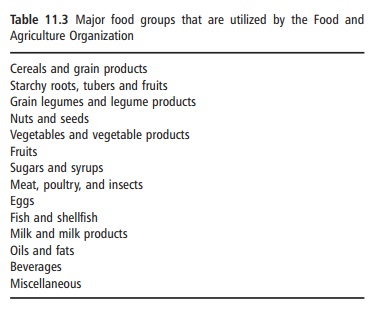
Sampling of foods for inclusion in tables
Food sampling concerns the selection of the individ-ual units of foods, food products, or bulk foodstuffs from the food supply or source, whether it be the marketplace, manufacturing outlet, field or the homes of the members of the study population. (Sampling also concerns the selection of the representative aliquot from the individual unit or homogenized mixture in the laboratory just before analysis.) In-context sampling can be defined as the selection and collection of items of food defined in number, size, and nature to represent the food under consideration. The objectives for sampling will, in the large part, determine the type and nature of the sampling plan.
One of the major objectives of food sampling is to provide representative mean values for individual components in foods. The sampling process is described in detail in Table 11.4.

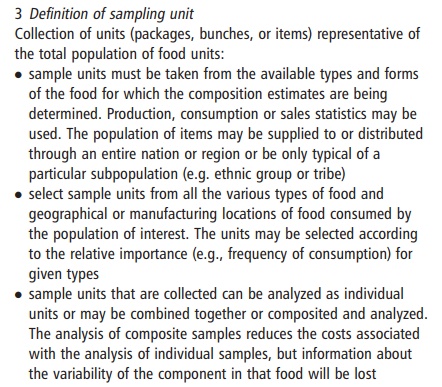
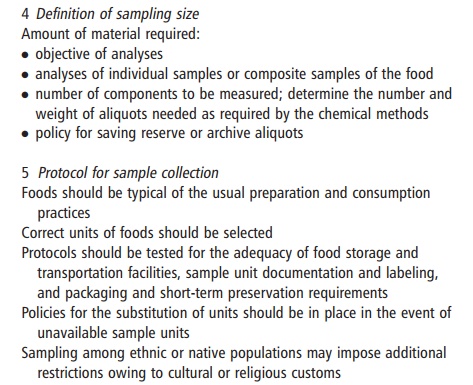
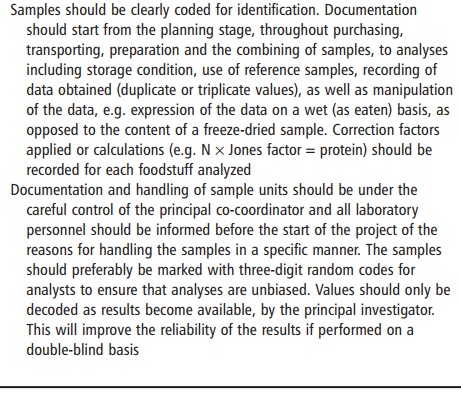
Food sampling is a critical step in any food com-position program. For any research project, personnel and financial resources are always limited. The selec-tion, procurement, shipping, and storage of sample units require a significant portion of available resources. Therefore, sampling must follow a specific and detailed statement of the objectives and proce-dures to ensure that the selection of units is sufficient in number and weight and representative of the foods of interest. If sampling or sample preparation is done incorrectly then all subsequent analyses are a waste of time and money, as a mistake in sampling can only be corrected by repurchasing and repreparing of a new sample. Pilot studies, conducted by the investigator(s) or published in the scientific literature, can be used as the basis of sampling decisions for the current study.
Variability in foods: regional and other differences
Foods are biological materials and, as such, have a naturally variable composition. Even processed foods produced under highly controlled circumstances show some variability. Therefore, a database must be able to predict the composition of a single sample of food within the limits defined by its natural variabil-ity. Variability may be contributed by one or more of the following factors: brand, cultivars or species, season, climate, geographical location (e.g., soil type), fertilizer treatment, method of husbandry, harvesting, preservation state, stage of maturity, enrichment/for-tification standards, preparation methods, food color, variation in recipes and formulations, distribution and marketing practices, and other factors. For critical components variability may affect the suffi-ciency, deficiency, or excess of the intake of a given component. Estimates of variability must be based on sampling and analyses specifically planned to yield such data. The intended use of the data should deter-mine the specificity and level of precision for the estimates.
For instance, it was found that the nutrient com-position of whole milk in South Africa differed among the five localities investigated between winter and summer, with the fat-soluble vitamins showing the greatest variation of all the nutrients. Vitamin A is commonly regarded as one of the micronutrients that are deficient in most developing countries and spe-cifically in disadvantaged schoolchildren in South Africa. Considering the results of the nutrient com-position of whole milk, a recommendation was made to the health authorities to fortify summer milk with retinol in the South African school-feeding intervention program, where milk is served as a mid-morning snack to 5 million primary school children.
There is a growing recognition that the composition of commodities such as meat and cereals tends to change over time. This necessitates updating food composition data every 5–10 years. In most countries this has not been possible. Changes in nutrient com-position of red meat consumed are due to consumer demand for leaner cuts, changes in breeding for faster growth, and higher proportions of marketable meat as well as changes in feed to meet scientific standards or due to economic reasons.
Related Topics